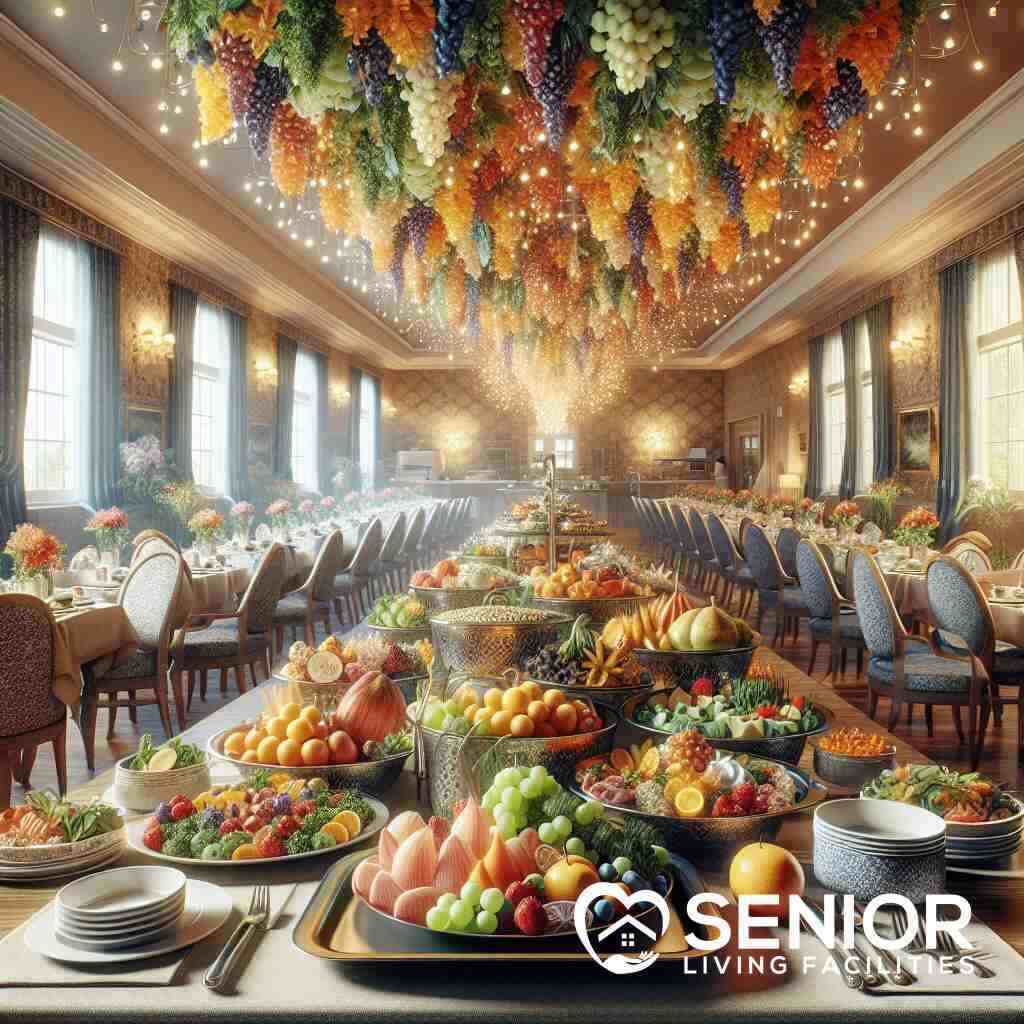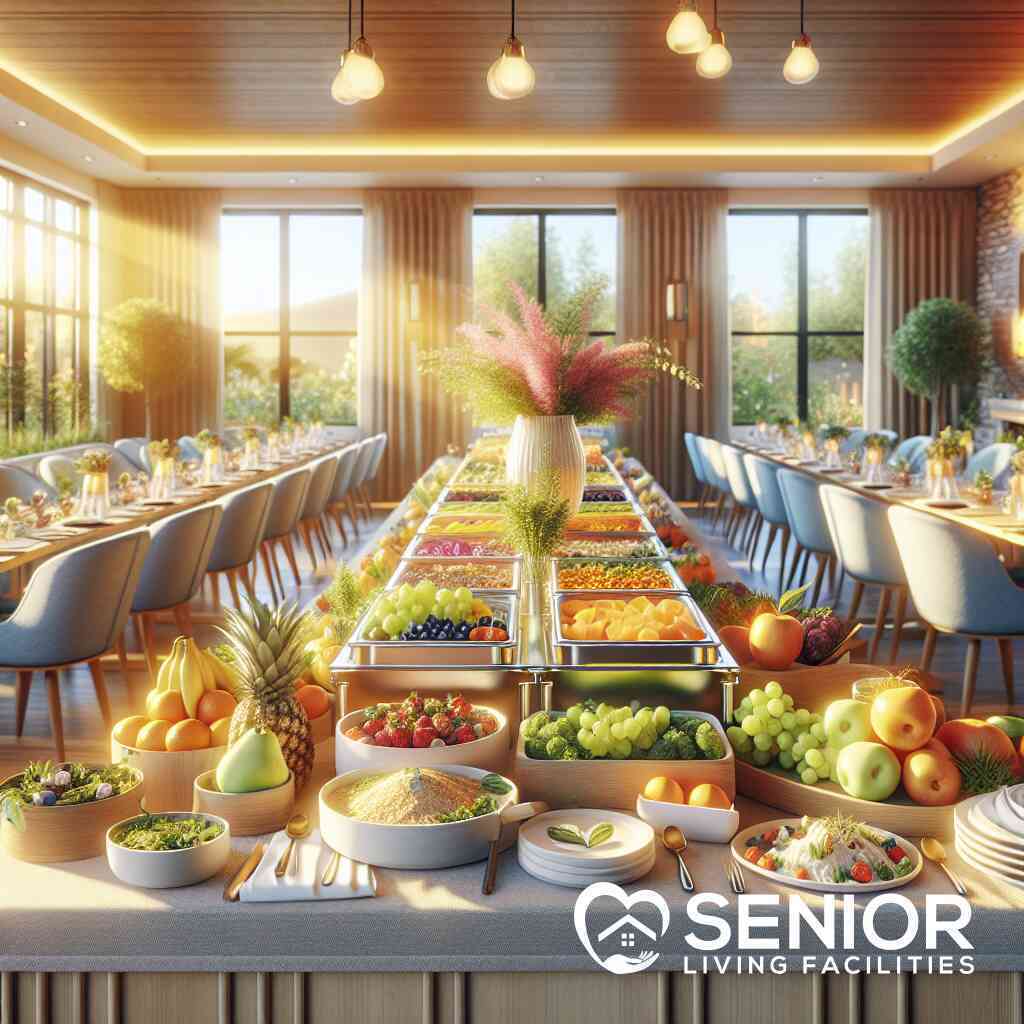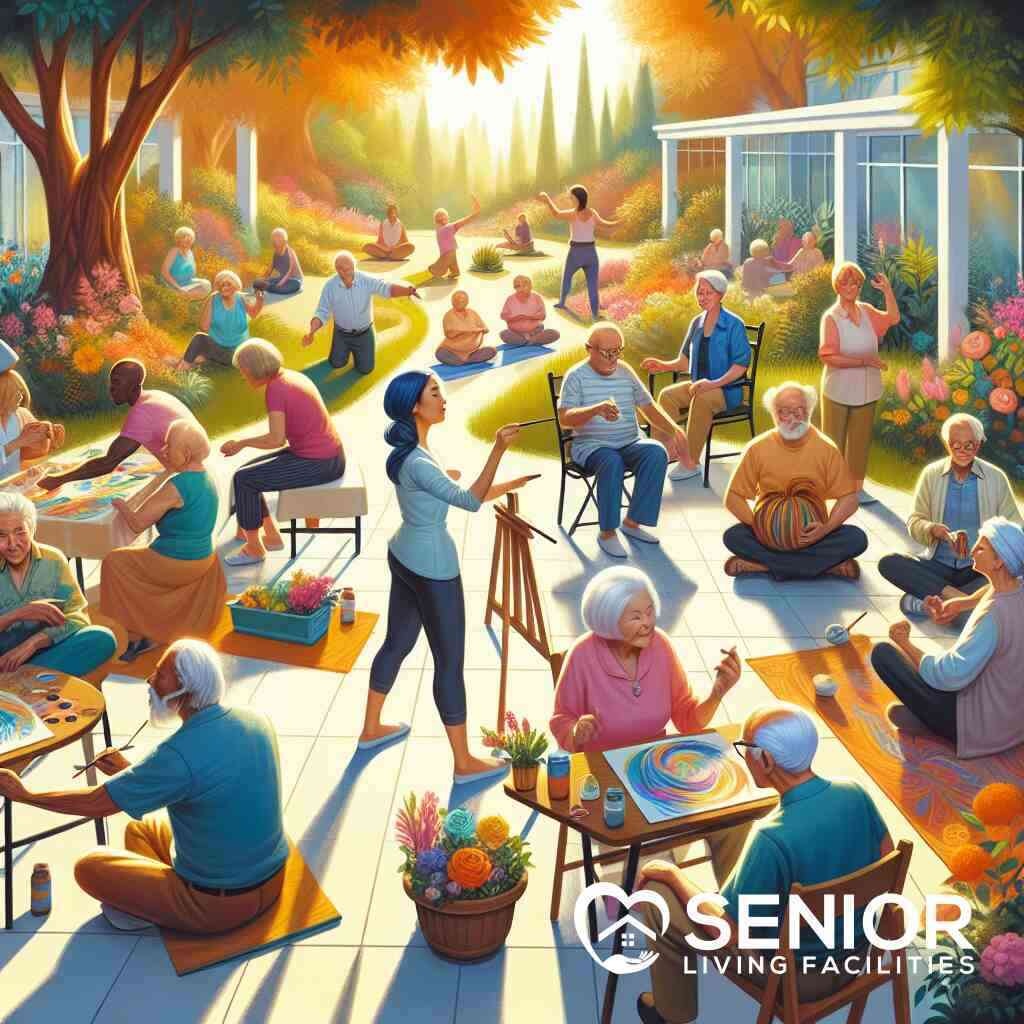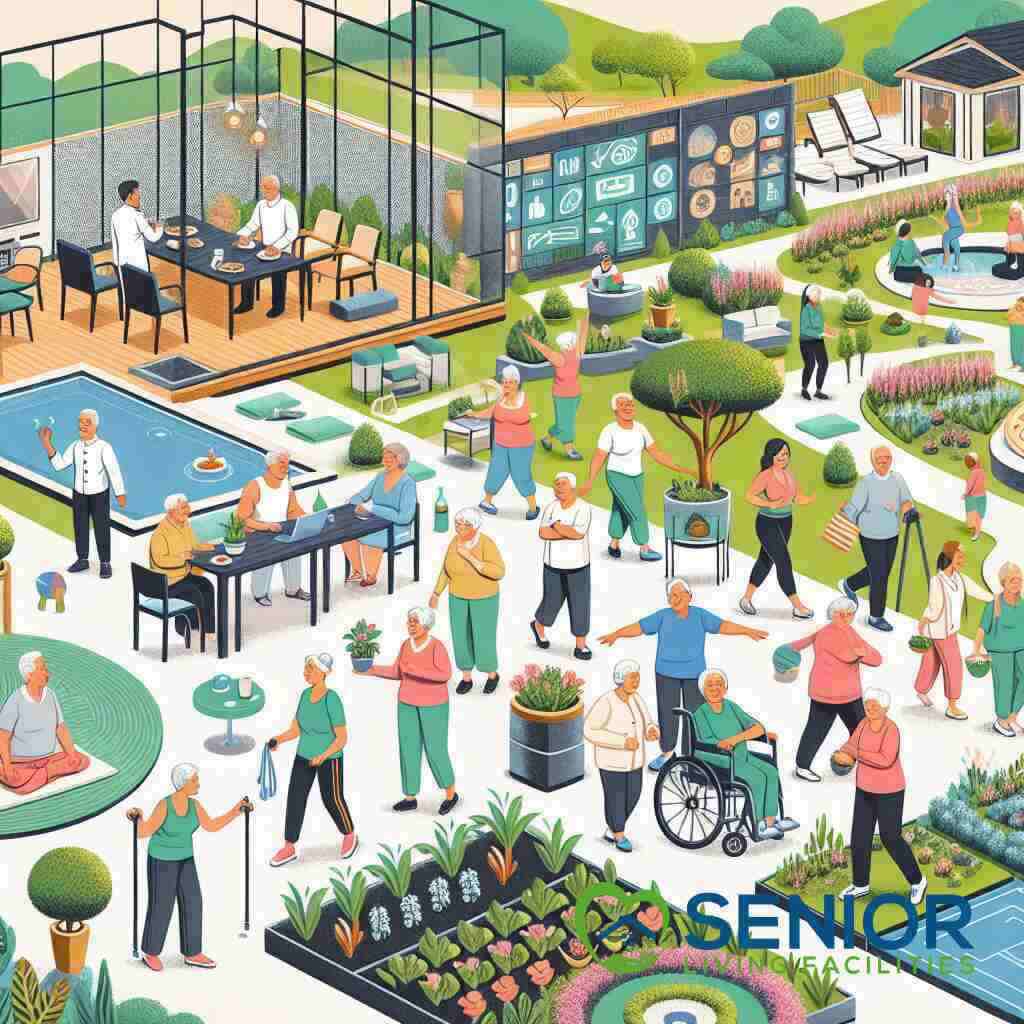
How to Identify Nutritious Dining in Senior Communities?
October 2, 2024
Nourishing Beginnings: Understanding the Importance of Nutrition in Senior Living
The Role of Nutrition in Senior Health
Nutrition significantly impacts the health and well-being of seniors, influencing everything from cognitive function to physical vitality. Proper nutrition helps seniors maintain their overall health, reducing the risk of chronic diseases such as diabetes and heart disease. Adequate dietary intake is crucial as it supports the body’s immune system, aids in managing weight, and improves mental clarity. By prioritizing nutrition, seniors can enjoy enhanced quality of life and increased longevity, making it a critical component of senior care.
Importance of Balanced Diet for Seniors
A balanced diet is foundational for seniors, providing essential nutrients needed for optimal health. Consuming a variety of foods ensures seniors receive the vitamins, minerals, and proteins necessary to maintain muscle mass, bone health, and energy levels. A well-rounded diet also aids in the prevention of nutrient deficiencies, which can lead to complications such as osteoporosis and anemia. By embracing a holistic dietary approach, seniors can maintain their independence and enjoy a more active lifestyle, underscoring the importance of informed food choices.
Common Nutritional Challenges in Senior Communities
Senior communities often face unique nutritional challenges, ranging from dietary restrictions to appetite changes seen with age. Seniors frequently experience diminished taste and smell, affecting their food preferences and consumption. Additionally, medical conditions like dysphagia can complicate nutrient intake, while medication interactions may impact nutritional absorption. Addressing these challenges involves creating adaptable meal plans and providing consistent support, ensuring that nutritious dining in senior communities becomes a tangible reality. Discover more about managing nutrition challenges in nutritious dining in senior communities on our platform.
Identifying Quality Dining in Senior Living Facilities
Key Indicators of Nutritious Dining Options
Identifying nutritious dining options in senior living facilities involves recognizing key indicators of quality meals. Facilities that emphasize locally sourced, organic ingredients often provide higher-quality nutrition. Look for menus that highlight variety and seasonality, offering a range of fruits, vegetables, whole grains, and lean proteins. Accessibility to dietitian services and regular nutritional assessments can also indicate a commitment to healthful eating. Transparency in nutritional information, with details about calories and macronutrient content, can empower seniors to make informed choices and is a positive indicator of nutritious dining options.
Furthermore, facilities that offer healthy meal plans for seniors often demonstrate a proactive approach to health and wellness. Such plans ensure meals are balanced and tailored to meet the specific nutritional requirements of the aging population. This personalized dietary approach can significantly enhance meal satisfaction and contribute to maintaining optimal health. By focusing on these qualities, families can identify dining options that align with seniors’ health goals and preferences.
Evaluating Senior Dining Experience
The senior dining experience goes beyond mere meal consumption- it’s about socialization, satisfaction, and culinary delight. To evaluate this aspect, consider facilities that prioritize a communal dining atmosphere, fostering interaction and engagement among residents. Facilities that offer a diverse array of dining settings, from formal dining rooms to casual cafes, add richness to the overall dining experience.
Facilities should also accommodate sensory changes, which are common in older age, by enhancing flavors without relying on excessive salt or sugar. Attention to aesthetic presentation can elevate the dining experience, making meals more enjoyable and visually appealing. Feedback mechanisms, where residents can voice preferences and suggestions, are also critical in continuously improving dining services. The senior living dining experience can, therefore, significantly impact the quality of life, making it a crucial factor in selecting the right facility.
Furthermore, evaluating assisted living meal experiences can benefit from firsthand observations and dining trials, allowing families to gauge the quality of food and service firsthand. Facilities that welcome such evaluations demonstrate confidence and transparency in their dining offerings. An inviting senior dining ambiance, combined with quality food and attentive service, defines an enriching dining experience for seniors.
Professional Culinary Services for Seniors
Professional culinary services play a pivotal role in delivering nutritious meals in senior living facilities. Skilled chefs are adept in preparing meals that cater to varying dietary needs and preferences to ensure seniors receive customized nutrition. An emphasis on culinary artistry ensures meals are not only nutritious but also delicious and appealing.
Facilities that invest in experienced culinary teams often provide tailored meal options, accommodating dietary restrictions such as low sodium, diabetic-friendly, or heart-healthy diets. By leveraging professional culinary services for seniors, these facilities can elevate the dining experience through innovative cooking techniques and exciting menus. Such services not only support better nutrition but also enrich the social and cultural aspects of dining.
Additionally, professional culinary teams often collaborate with nutritionists to ensure meals align with the latest dietary recommendations and health standards. This holistic approach supports a balanced diet in assisted living and helps manage health conditions through appropriate nutrition. For more insights on what defines excellent culinary services, explore professional culinary services for seniors, highlighting how dining excellence contributes to overall resident satisfaction and well-being.
Exploring Senior Living Dining Options
Meals for Seniors in Assisted Living
Meals in assisted living facilities should not only meet basic nutritional needs but also enrich the seniors’ dining experience. Facilities offering healthy dining for the elderly prioritize fresh ingredients and health-conscious recipes that cater to the individual needs of residents. The integration of comfort foods, seasonal dishes, and culturally diverse offerings can invigorate a senior’s palate and nourish their spirit. These facilities need to maintain a flexible dining schedule that accommodates varying appetites and preferences throughout the day.
Dining services in assisted living environments must also account for necessary dietary restrictions, ensuring all meals adhere to medical guidelines. Establishments with dedicated nutritionists and culinary experts tailor dining plans to each resident’s health profile, such as diabetic or low-cholesterol diets. By providing fortified and palatable meal options, assisted living centers can significantly enhance the quality of life for their residents. Explore more about evaluating assisted living meal experiences to understand how these meals contribute to overall well-being.
Understanding Senior Apartment Rentals with Dining Services
Senior apartment rentals offering dining services present a unique blend of independence and support. These living arrangements often feature community dining halls where residents can partake in chef-prepared meals without the stress of cooking. The availability of meal packages allows seniors to enjoy nutritious dining options in a communal setting while maintaining their chosen lifestyle.
The food service in these rentals frequently emphasizes a balanced diet, focusing on heart-healthy and senior-focused nutrition. Dining plans typically include three meals a day, with the option for special dietary accommodations and snack availability. This model not only alleviates the burden of meal preparation but also promotes social interaction among residents. Understanding the offerings and flexibility within senior apartment rentals is crucial for those seeking a seamless transition into supported living while enjoying delicious and healthful meals.
Communities for Seniors 55+ and Their Dining Choices
Dining choices within communities for seniors 55+ are diverse, catering to the active and varied lifestyle of this demographic. These communities often boast multiple dining venues, from restaurants and cafes to formal dining rooms, offering an array of culinary experiences. Residents can usually find options for every meal type, from casual breakfasts and healthy lunches to gourmet dinners.
Menus in these communities often focus on offering healthy cuisine in senior communities, which elevates the dining experience through gourmet dishes and farm-to-table options. The variety and customization available ensure that residents can enjoy flavorful and nutritious meals daily. With attention to residents’ feedback and modern culinary trends, these communities continually enhance their dining services, promoting an engaging and enriching dining atmosphere.
Customization and Flexibility: Catering to Dietary Needs
Assessing the Dietary Needs of Seniors
Understanding and assessing the dietary needs of seniors is critical in crafting nutritious dining experiences. Each senior may have distinct health conditions requiring specific nutritional attention. Evaluating these needs involves collaborative efforts among healthcare professionals, nutritionists, and culinary teams to create comprehensive meal plans. Facilities that prioritize assessing dietary needs can better cater to individual preferences by providing flavor, flexibility, and nourishment in each meal. By focusing on thorough assessments, senior living communities can effectively cater to the dietary needs of seniors, fostering a healthier lifestyle.
Individual preferences and health goals should shape the foundations of a senior’s diet. This approach ensures that seniors enjoy meals tailored to their tastes while meeting medical guidelines. Facilities that utilize upfront assessments can craft detailed and nuanced meal plans that anticipate and meet residents’ evolving dietary requirements. Such attention highlights the importance of ongoing dialogue between residents and staff, ensuring nutritional plans adapt as health needs change. By fostering this adaptive environment, senior communities can safeguard resident health and satisfaction through personalized dietary solutions.
Nutritious Menu Options for Varied Health Conditions
Crafting a menu that caters to diverse health conditions is essential in senior living facilities. Nutritious menu options should address common elderly concerns like hypertension, diabetes, and cholesterol control. By offering a wide array of nutrient-dense foods, facilities can help residents manage these conditions more effectively. The integration of superfoods, rich in vitamins and antioxidants, can aid in disease prevention and promote overall well-being. Nutritious menus for seniors often feature these options, appealing to both health needs and taste buds.
Facilities should focus on meal inclusivity, accommodating restrictions like gluten-free, low-sodium, and heart-healthy diets. Creative modifications ensure meals remain appealing and flavorful despite dietary constraints. Balance and variety are key, with careful attention to nutritional content, serving size, and meal timing. With these considerations, senior living facilities can provide tailored meals that enhance health management and enrich the dining experience. By embracing this strategy, communities pave the way for healthier, happier residents.
Importance of Personalized Senior Meal Plans
Personalized meal plans play a vital role in maintaining the health and satisfaction of seniors in residential settings. Customization based on individual health profiles enables facilities to offer meals that meet specific nutritional needs while respecting personal taste preferences. By investing in healthy meal plans for seniors, facilities prioritize residents’ well-being, allowing for a dignified and enjoyable dining experience.
Effective senior meal planning involves regular consultations with dietitians to ensure dietary guidelines align with current health data and lifestyle changes for more information on navigating senior living options near you. Adapting menus to reflect seasonal ingredients and modern culinary trends can keep meal offerings dynamic and engaging. Facilities that embrace flexibility and personalization in meal plans demonstrate a proactive commitment to resident care, boosting both satisfaction and outcomes.
The importance of personalized meal plans extends beyond nutrition, tying into emotional and social wellness. Tailored menus that reflect cultural backgrounds and personal histories can foster a sense of community and belonging among residents. By empowering seniors to express their preferences, facilities champion inclusivity and autonomy, essential elements in today’s senior living environments.
Senior Nutrition and Health: Ensuring a Balanced Approach
Nutritional Support in Senior Living
Nutritional support in senior living facilities is an essential aspect of promoting overall health and well-being among residents. It involves providing meals rich in essential nutrients and tailored to meet the unique dietary needs of seniors. Access to nutritionists and dietitians within these communities ensures that residents receive advice on proper dietary practices and meal preparation. Facilities that offer comprehensive nutritional support in senior living facilities empower seniors to make informed food choices, enhancing their health outcomes. By fostering such an environment, these communities significantly contribute to the reduction of age-related health risks and promote longevity.
In addition to offering nutritious meals, these facilities encourage residents to participate in meal planning and preparation activities. Such engagement not only enhances their autonomy but also instills a sense of accomplishment and purpose. Attentive staff members can provide guidance on portion sizes, nutritional labels, and healthy cooking techniques. This educational support is crucial for residents managing chronic conditions like diabetes, hypertension, or high cholesterol. By implementing strategic nutritional support systems, senior living facilities create a foundation for healthier and more fulfilled lives.
Incorporating Healthy Cuisine for Seniors
Incorporating healthy cuisine in senior communities ensures a robust dining experience that aligns with the nutritional needs of elderly residents. Explore healthy cuisine in senior communities. This involves creating diverse menus that focus on whole foods, lean proteins, and fresh produce to maximize health benefits. Chefs and culinary teams within these communities strive to balance flavor and nutrition, crafting meals that are both satisfying and beneficial for seniors’ health. The inclusion of superfoods and seasonal ingredients enhances the palatability and nutritional value of the meals served.
Senior communities often offer cooking demonstrations and workshops as part of their activities, encouraging residents to explore healthy eating habits. These initiatives aim to educate and empower seniors, promoting an understanding of which ingredients contribute to a well-rounded diet. Additionally, by providing alternative dietary options such as vegetarian, gluten-free, or low-sodium meals-communities accommodate various health needs and personal preferences. Learn more about senior living amenities that enhance daily life. Celebrating cultural diversity through cuisine also plays a role in enhancing the dining experience, making meals enjoyable and reminiscent of the residents’ culinary heritage.
Monitoring Senior Dietary Guidelines
Monitoring senior nutritional guidelines is crucial in ensuring that dietary practices in senior communities support long-term health objectives. Regular assessments of dietary intake and meal planning help in aligning meals with established nutrition standards for elderly individuals. Facilities implementing state-of-the-art tracking systems can screen for deficiencies and adjust dietary plans accordingly, maintaining alignment with evolving health needs.
Health professionals, including dietitians and caregivers, play an integral role in educating seniors about current dietary guidelines and their implications. Engaging residents in interactive sessions about nutrition helps in reducing misinformation and encourages adherence to recommended dietary practices. Furthermore, having access to dietary data can help residents make informed decisions, fostering a culture of wellness literacy within the community.
Staying updated with advancements in nutritional science also supports the continuous improvement of dining services. Consequently, senior living facilities benefit from administering regular evaluations and feedback mechanisms to ensure their dining services meet or exceed standards. This proactive approach to monitoring dietary guidelines forms the bedrock for improved health and vitality among senior residents.
Connecting with Senior Living Facilities for Optimized Nutrition
Using the Senior Living Locator for Nutritional Needs
To optimize nutrition in senior communities, using a Senior Living Locator can be an invaluable tool. Learn about comparing assisted living and home care services. This platform allows families to find ideal living arrangements that prioritize nutritious dining tailored to meet seniors’ dietary specialties. By inputting geographic preferences, users can compare facilities that emphasize a balanced diet in assisted living environments. Facilities that integrate nutrition into their wellness programs often offer personalized meal plans and on-site nutritionists. Such amenities ensure that each resident’s dietary needs are systematically addressed, fostering a proactive environment for senior nutrition.
Moreover, Senior Living Facilities provide a comprehensive database of communities that prioritize culinary excellence and nutrition management. This service showcases institutions with diverse dining options and culinary teams committed to seniors’ health and wellness. Families can learn about available amenities and, through consultation, select communities that resonate with their nutritional goals. With a dedicated focus on senior meal services, this locator aids in seamless transitions to residences that align with residents’ lifestyles and health needs. With these resources, you can ensure that older adults enjoy a nourishing and fulfilling dining experience.
Exploring Assisted Living Plans for Better Dining Experiences
Diving deep into assisted living plans reveals a dedication to enhancing senior dining experiences. Facilities sanctioned under these plans often prioritize diverse and nutritious dining menus, ensuring that elderly residents have access to meals that are both delicious and health-promoting. These dining options consider different health conditions and dietary restrictions, offering a variety of menu choices that cater to individual requirements.
Assisted living facilities regularly design their dining services with flexibility in mind, accommodating varied eating schedules and preferences. Some may offer innovative meal delivery systems within the community, ensuring that residents receive personalized care. A key aspect of these environments is the integration of resident feedback into meal-planning processes. This approach not only elevates dining satisfaction but also reflects a commitment to continuously enhancing culinary services in senior living communities across senior living facilities.
Engaging with such plans provides insight into how structure and service quality directly influence residents’ experiences. Facilities are continually adapting to incorporate various dietary advancements, proving their commitment to improving senior living by focusing on nutritious and enjoyable dining.
Connecting with Senior Dining Services Near You
Identifying senior dining services near you is paramount for families who prioritize advanced nutrition for their loved ones. By leveraging online tools such as senior living directories, families can locate nearby communities enriched with culinary excellence and diversified meal offerings. These directories offer detailed profiles highlighting the nutritional support available across different facilities.
Residents can tap into local dining services that not only cater to physical health but also enhance their social well-being. Dining in these facilities often goes beyond nutrition, establishing a communal experience that encourages interaction and engagement. The concept of senior dining services near me ensures residents and families are well-informed of options within accessible locations, augmenting their decision-making capabilities.
By connecting with these services, one can further understand the interplay between diet and lifestyle in age-restricted habitats. Engaging with nutritionists or culinary professionals through these avenues assures families that seniors receive consistent, healthful, and enjoyable meals. It is this comprehensive approach that sets the foundation for optimizing wellness in senior communities.
Culinary Sustainability: Future of Nutritious Dining in Senior Communities
Innovative Trends in Senior Meal Services
The landscape of senior meal services is undergoing a dynamic transformation driven by innovative trends that prioritize nutrition and satisfaction. Currently, there is a marked shift towards incorporating farm-to-table initiatives, ensuring freshness and sustainability in every dish. Digital meal planning is also gaining traction, offering interactive platforms for residents to customize their dining experiences, aligning with their personal health goals.
Another trend is the adoption of technology-enhanced kitchens equipped with advanced cooking tools that preserve nutrients and enhance flavor profiles. Discover the rise of technology in senior living facilities for 2024. This evolution reflects a broader commitment to providing nutritious food for elderly residents, ensuring meals are both beneficial and enjoyable. Moreover, facilities are embracing the concept of flexible dining options, allowing seniors to dine according to their preferred schedule and and fostering an environment of autonomy and culinary delight. Read more about these transformative trends in nutritious food for the elderly.
Sustainable Practices in Senior Dining Facilities
Sustainability is increasingly becoming intrinsic to dining practices within senior living facilities, addressing both environmental impact and resident health. Facilities are implementing systematic waste reduction strategies, using composting and recycling methods to minimize their ecological footprint. This approach extends to sourcing local and organic produce, reducing carbon emissions linked to transportation, and ensuring higher nutritional values in meals.
The role of energy-efficient appliances in kitchen operations also plays a critical part in sustainability efforts. Many facilities are now opting for appliances that consume less power while delivering optimal performance, balancing environmental responsibility with culinary excellence. Moreover, sustainable practices include reducing single-use plastics, opting for eco-friendly packaging, and promoting plant-based menu options, which are known for their lower environmental impact. These endeavors highlight a commitment to incorporating sustainable practices that align with a balanced diet in retirement homes, enhancing the overall quality of senior living.
Looking Ahead: Improving Nutrition in Senior Living Settings
As we look to the future, improving nutrition in senior living settings requires ongoing adaptation and foresight. Facilities must focus on continuous education and training for culinary and support staff, ensuring they are equipped to meet residents’ evolving nutritional needs. Robust frameworks for resident feedback and engagement allow for a dynamic dining culture that reflects contemporary nutritional science and resident preferences.
Integrating advanced nutrition analytics can also revolutionize meal planning, allowing for a more targeted and prescriptive approach tailored to individual dietary needs. This technology enables real-time monitoring of nutrient intake, providing invaluable insights into how seniors can maintain optimal health through diet. Furthermore, embracing a holistic view of wellness that intertwines social interaction with nutritious dining experiences can significantly enhance residents’ quality of life.
Looking forward, senior living communities are poised to become hubs of dietary innovation, embracing trends that foster both delicious and nutritionally comprehensive dining experiences. By focusing on a future that marries tradition with modernization, these communities pave the way for healthier, more vibrant living environments fostered by meticulous attention to nutritious and sustainable dining practices.
Frequently Asked Questions
Question: What are the key indicators of nutritious dining options in senior living facilities?
Answer: Identifying nutritious dining options in senior living facilities involves looking for several key indicators. Facilities that prioritize locally sourced, organic ingredients often provide higher-quality meals. Menus that highlight variety with a focus on seasonality, offering an array of fruits, vegetables, whole grains, and lean proteins, suggest a commitment to a balanced diet for seniors. Access to dietitian services and regular nutritional assessments also indicate a facility’s dedication to healthful dining. Additionally, transparency in nutritional information, including details about calories and macronutrient content, empowers seniors to make informed dietary choices, ensuring a holistic approach to senior nutrition.
Question: How do Senior Living Facilities ensure a balanced diet for seniors through their services?
Answer: At Senior Living Facilities, we understand the importance of a balanced diet for maintaining the health and well-being of seniors. To support this, we showcase communities that offer personalized senior meal plans crafted by experienced culinary teams and nutritionists. These plans take into account individual dietary needs, preferences, and health goals, providing tailored meal solutions that include healthy senior meals. By featuring facilities with comprehensive nutritional support and dining services, we ensure that seniors enjoy nutritious and satisfying dining experiences that cater to their unique dietary requirements. Discover more about wellness programs in senior living facilities.
Question: How is the quality of the senior dining experience evaluated at Senior Living Facilities?
Answer: The senior dining experience is evaluated based on several factors that go beyond the nutrition of the meals provided. At Senior Living Facilities, we emphasize the importance of a communal dining atmosphere that promotes social interaction and engagement among residents. Facilities that offer varied dining settings, from formal dining rooms to casual cafes, enhance the residents’ experience. Learn more about the best senior living facility options. Quality dining experiences also consider sensory changes common in seniors by enhancing flavors healthily and focusing on aesthetics. Feedback mechanisms that allow residents to voice their preferences ensure continuous improvement in dining services, thus enhancing the senior dining experience overall.
Question: How can families use a Senior Living Locator to find communities with nutritious dining options?
Answer: Families searching for communities with nutritious dining options can utilize the Senior Living Locator offered by Senior Living Facilities. By entering their geographic preferences, users can compare various facilities that emphasize healthy dining options for seniors. Our platform highlights communities that integrate nutrition into their wellness programs, offering personalized meal plans and on-site nutritionists. This tool simplifies the process of finding living arrangements where seniors’ dietary needs are systematically addressed, ensuring a nourishing and fulfilling dining experience. Discover more tips on navigating senior living options. With our locator, families can confidently choose facilities that align with their loved ones’ health goals and lifestyle needs.
Question: What role does culinary service play in senior communities as part of Senior Living Facilities?
Answer: Culinary services play a pivotal role in senior communities affiliated with Senior Living Facilities by ensuring that residents receive nutritious and appealing meals. Skilled chefs and culinary teams prepare meals that cater to various dietary needs and preferences, incorporating healthy cuisine for seniors. These teams work closely with nutritionists to ensure that menus align with dietary guidelines and health standards. Such professional culinary services enhance the overall dining experience, supporting better nutrition and contributing to the residents’ social and cultural enrichment. Learn about luxury senior living offerings. This emphasis on quality dining helps to maintain the seniors’ health and satisfaction, showcasing our commitment to excellence in senior living nutrition.




